
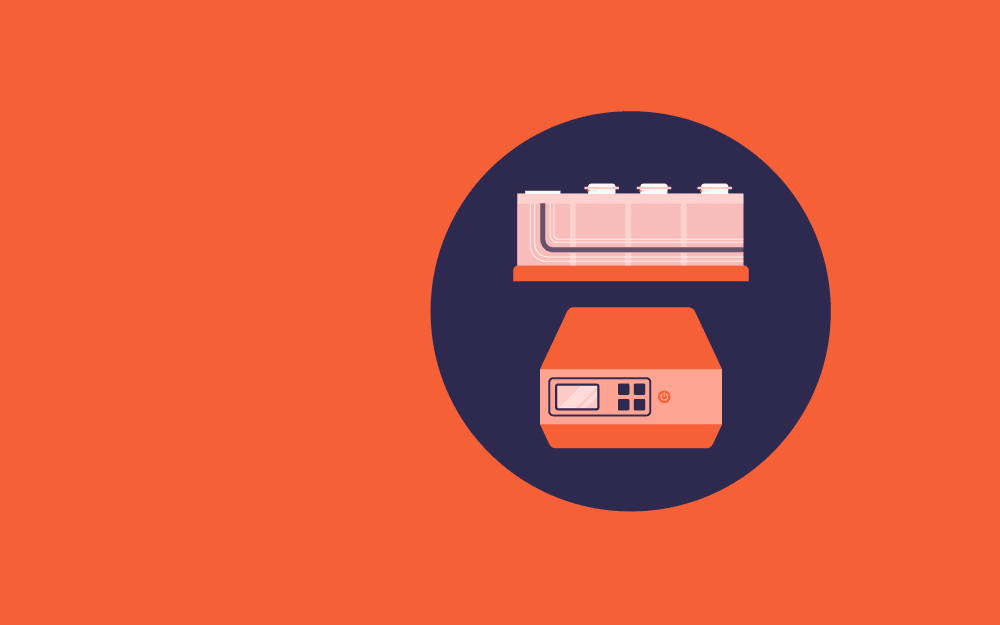
Cells are building blocks of organisms. Thus, understanding the whole metabolic processes and dynamics of organisms requires us to look clearly inside cells.
Advanced microscopy technologies combined with protein labeling approaches have enabled scientists to understand cellular processes and investigate the dynamic processes in organisms with better resolution and sensitivity.[1]
The quality optical conditions can only be obtained using high numerical aperture oil-immersion objective lenses that work with a cover slip of a very specific refractive index (η = 1.515) and thickness (0.15 mm).[2] Any deviation from these parameters can impact the resolution and quality of the obtained image.
Also, a system that can meet the physical requirements of such high-throughput experiments is required. These requirements are chemoattractant gradient generation, shear flow, electrophysiology electrodes, the introduction of stimuli, and multiple wells for multiplex or multimodal imaging.[2] All this can only be achieved by using high-quality imaging chambers.
Imaging chambers are tools used in labs working on microscopy techniques to conserve specimens and control the environment around them, such as temperature, air quality, and humidity. With them, specimens are observed with minimal invasion at high resolution.
After the development of mammalian cell culture techniques, the first live-cell imaging chamber was introduced in the early 20th century.[3]
From simple coverslip sealed on a microscope to sophisticated open and closed perfusion chambers in open-well or channel format, the technology of the imaging chambers has evolved progressively. Here are some things to know about imaging chambers:
Allows for easy changes in the culture media; this ensures that tissues grow at a healthy pace and samples are imaged at the required high numerical apertures.[4]
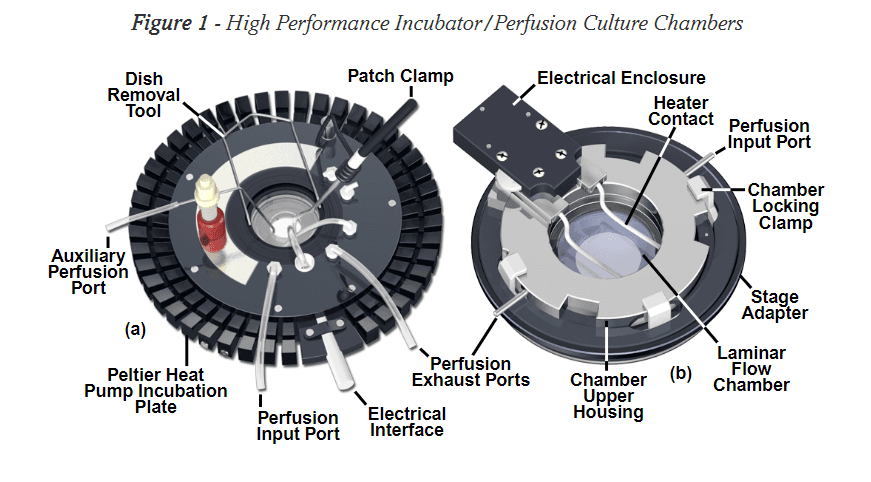
Figure: Image of a Perfusion Imaging Chamber.[4]
Simple microscope slides with a coverslip are used for short-term (20-30 minutes) experiments.[4] It’s enough to protect adherent cells from physical stress that can lead to autofluorescence.
Coverslips are sealed using molten agarose, vacuum grease, rubber cement, or a useful preparation known as VALAP (a 1:1:1 mixture of vaseline, lanolin, and paraffin).[4] This prevents the evaporation of culture media and maintains viable cells.
The prepared slide can be stored on a small heating block near the microscope or carbon dioxide incubator between image gathering sessions.[4]
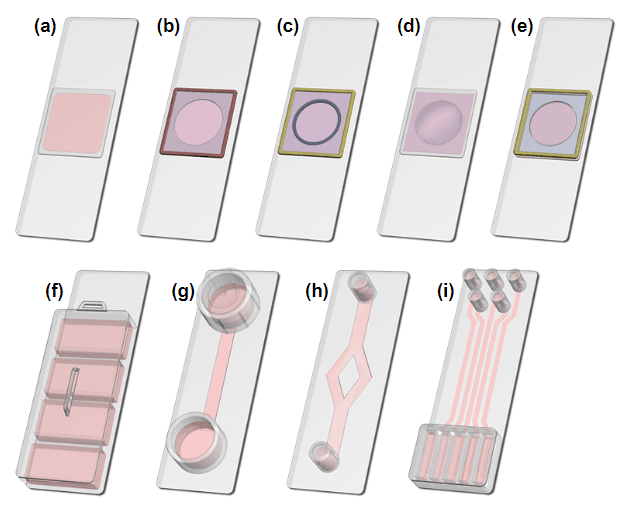
Figure: Different types of simple microscope slide imaging chambers.[4]
However, the Petri dish culture and imaging chamber is a standard 35 or 50-millimeter disposable Petri dish with a 10-, 14-, and 20-mm circular opening and covered with a borosilicate coverslip to observe living cells at high resolution.[4] They always contain large amounts of media which minimize cell damage due to sudden changes in pH and temperature.
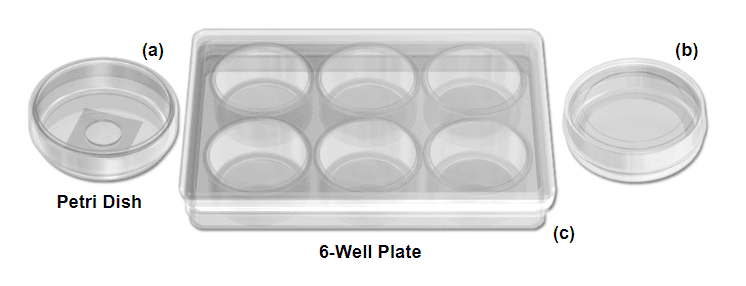
Figure: Different types of Petri-dish imaging chamber.[4]
They are available as both open and closed perfusion chambers. The open perfusion chamber is similar to custom microscopy slides and Petri dishes. Its advantages include:[4]
One limitation of the open perfusion chamber is that it does not provide sufficient control over the cells’ environment.[3] The technique is more suitable for experiments in which high-resolution transmitted light techniques are not required.
The closed perfusion chamber is sealed to protect cell cultures against environmental variables, such as temperature, osmolarity, pH, and carbon dioxide concentration.[4]
In these systems, fresh medium or other chemicals are added through a port, regulated by either a motor-driven syringe, a peristaltic pump, or through a gravity-controlled manifold.[4] They are most suited for long-term experiments.
One limitation of closed perfusion imaging chambers is that they do not allow easy access to the cells during experiments.
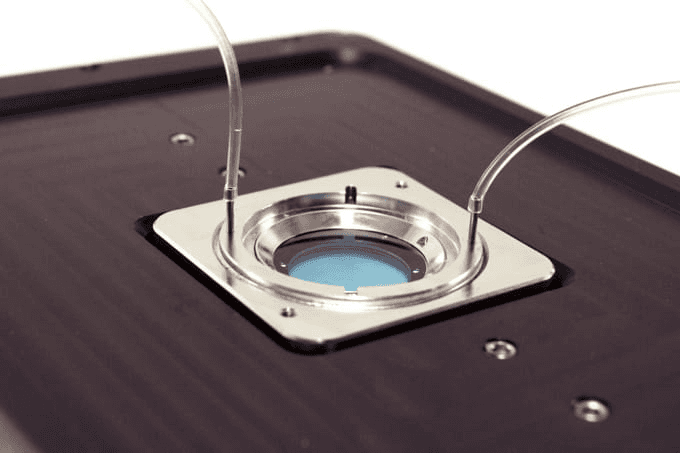
Figure: Image of an advanced perfusion imaging chamber.[3]
While designing a microscopy experiment, researchers should first determine working distance restrictions, necessary magnification range, and optimum numerical aperture of the depth field of the microscope.[4] The chamber used in the experiment must be chosen in a way that it is perfectly paired with the set physical conditions.
For example, in transmitted light applications that require a high numerical aperture condenser, the imaging chamber should accommodate the physical size, working distance, and proximity of the condenser front lens element.[4] And to ensure optimum image clearance, the dimension of the culture chamber should match the geometry of the microscope stage.
For such situations, the advanced open and closed system imaging chamber works best for the experiments.
While using an open system imaging chamber, consider characteristics like construction material, chamber geometry, volume, coverslip thickness, aperture size, and biocompatibility.[4] Factors affecting your experiment with these systems include ambient light, evaporation (and condensation), and lab conditions.
Closed system imaging chambers are used when the culture must be completely isolated from the external environment or for transmission optical microscopy applications that require advanced contrast-enhancing techniques.[4]
For closed system imaging chambers, other factors in addition to those involved in the open system are laminarity, shear stress, the separation distance between optical surfaces, fixed or variable chamber volume requirements, and flow channel geometry.[4]
It’s a combination that can either be utilized as a static chamber or a perfusion device to simulate the conditions found in a humidified carbon dioxide incubator. In the device, a circular, heated water tank is equipped with carbon dioxide injectors, fed by the remote gas-mixing unit to maintain high humidity inside the chamber.[4] Fresh medium and metabolites are added in the chamber through an access port in the cover glass.
It’s most suited for applications like polarized light imaging techniques and transmitted light differential interference contrast at a low numerical aperture.[4]
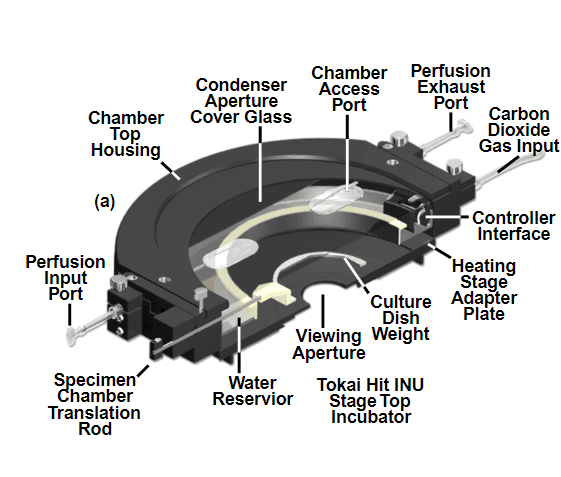
Figure: Image of a Tokai hit stage incubator.[4]
Cell-based analyses or tissue incubations are carried out in imaging chambers, followed by processing of the microscopy slides carrying the sample.[5] These imaging chambers have many applications in labs including:[5]
Imaging chambers are essential tools in biological labs for imaging live cells and tissues. They have major applications in the short-term storage of cells or tissues and help maintain a suitable optimum environment for cells.
Today, a range of designs for imaging chambers are available that are employed based on the microscopy experimental goals. Some known imaging chambers are simple microscopy slide chambers, petri dish chambers, perfusion chambers (extensively used ones), and high-stage incubators.
Live cell imaging is gaining more popularity in cell and molecular biology for its extensive applications in providing better insight into cellular processes and dynamics.[4]
Check out our Visual Patching and Imaging Chamber if you want a high-quality imaging device for your lab.
In behavioral neuroscience, the Open Field Test (OFT) remains one of the most widely used assays to evaluate rodent models of affect, cognition, and motivation. It provides a non-invasive framework for examining how animals respond to novelty, stress, and pharmacological or environmental manipulations. Among the test’s core metrics, the percentage of time spent in the center zone offers a uniquely normalized and sensitive measure of an animal’s emotional reactivity and willingness to engage with a potentially risky environment.
This metric is calculated as the proportion of time spent in the central area of the arena—typically the inner 25%—relative to the entire session duration. By normalizing this value, researchers gain a behaviorally informative variable that is resilient to fluctuations in session length or overall movement levels. This makes it especially valuable in comparative analyses, longitudinal monitoring, and cross-model validation.
Unlike raw center duration, which can be affected by trial design inconsistencies, the percentage-based measure enables clearer comparisons across animals, treatments, and conditions. It plays a key role in identifying trait anxiety, avoidance behavior, risk-taking tendencies, and environmental adaptation, making it indispensable in both basic and translational research contexts.
Whereas simple center duration provides absolute time, the percentage-based metric introduces greater interpretability and reproducibility, especially when comparing different animal models, treatment conditions, or experimental setups. It is particularly effective for quantifying avoidance behaviors, risk assessment strategies, and trait anxiety profiles in both acute and longitudinal designs.
This metric reflects the relative amount of time an animal chooses to spend in the open, exposed portion of the arena—typically defined as the inner 25% of a square or circular enclosure. Because rodents innately prefer the periphery (thigmotaxis), time in the center is inversely associated with anxiety-like behavior. As such, this percentage is considered a sensitive, normalized index of:
Critically, because this metric is normalized by session duration, it accommodates variability in activity levels or testing conditions. This makes it especially suitable for comparing across individuals, treatment groups, or timepoints in longitudinal studies.
A high percentage of center time indicates reduced anxiety, increased novelty-seeking, or pharmacological modulation (e.g., anxiolysis). Conversely, a low percentage suggests emotional inhibition, behavioral avoidance, or contextual hypervigilance. reduced anxiety, increased novelty-seeking, or pharmacological modulation (e.g., anxiolysis). Conversely, a low percentage suggests emotional inhibition, behavioral avoidance, or contextual hypervigilance.
The percentage of center time is one of the most direct, unconditioned readouts of anxiety-like behavior in rodents. It is frequently reduced in models of PTSD, chronic stress, or early-life adversity, where animals exhibit persistent avoidance of the center due to heightened emotional reactivity. This metric can also distinguish between acute anxiety responses and enduring trait anxiety, especially in longitudinal or developmental studies. Its normalized nature makes it ideal for comparing across cohorts with variable locomotor profiles, helping researchers detect true affective changes rather than activity-based confounds.
Rodents that spend more time in the center zone typically exhibit broader and more flexible exploration strategies. This behavior reflects not only reduced anxiety but also cognitive engagement and environmental curiosity. High center percentage is associated with robust spatial learning, attentional scanning, and memory encoding functions, supported by coordinated activation in the prefrontal cortex, hippocampus, and basal forebrain. In contrast, reduced center engagement may signal spatial rigidity, attentional narrowing, or cognitive withdrawal, particularly in models of neurodegeneration or aging.
The open field test remains one of the most widely accepted platforms for testing anxiolytic and psychotropic drugs. The percentage of center time reliably increases following administration of anxiolytic agents such as benzodiazepines, SSRIs, and GABA-A receptor agonists. This metric serves as a sensitive and reproducible endpoint in preclinical dose-finding studies, mechanistic pharmacology, and compound screening pipelines. It also aids in differentiating true anxiolytic effects from sedation or motor suppression by integrating with other behavioral parameters like distance traveled and entry count (Prut & Belzung, 2003).
Sex-based differences in emotional regulation often manifest in open field behavior, with female rodents generally exhibiting higher variability in center zone metrics due to hormonal cycling. For example, estrogen has been shown to facilitate exploratory behavior and increase center occupancy, while progesterone and stress-induced corticosterone often reduce it. Studies involving gonadectomy, hormone replacement, or sex-specific genetic knockouts use this metric to quantify the impact of endocrine factors on anxiety and exploratory behavior. As such, it remains a vital tool for dissecting sex-dependent neurobehavioral dynamics.
The percentage of center time is one of the most direct, unconditioned readouts of anxiety-like behavior in rodents. It is frequently reduced in models of PTSD, chronic stress, or early-life adversity. Because it is normalized, this metric is especially helpful for distinguishing between genuine avoidance and low general activity.
Environmental Control: Uniformity in environmental conditions is essential. Lighting should be evenly diffused to avoid shadow bias, and noise should be minimized to prevent stress-induced variability. The arena must be cleaned between trials using odor-neutral solutions to eliminate scent trails or pheromone cues that may affect zone preference. Any variation in these conditions can introduce systematic bias in center zone behavior. Use consistent definitions of the center zone (commonly 25% of total area) to allow valid comparisons. Software-based segmentation enhances spatial precision.
Evaluating how center time evolves across the duration of a session—divided into early, middle, and late thirds—provides insight into behavioral transitions and adaptive responses. Animals may begin by avoiding the center, only to gradually increase center time as they habituate to the environment. Conversely, persistently low center time across the session can signal prolonged anxiety, fear generalization, or a trait-like avoidance phenotype.
To validate the significance of center time percentage, it should be examined alongside results from other anxiety-related tests such as the Elevated Plus Maze, Light-Dark Box, or Novelty Suppressed Feeding. Concordance across paradigms supports the reliability of center time as a trait marker, while discordance may indicate task-specific reactivity or behavioral dissociation.
When paired with high-resolution scoring of behavioral events such as rearing, grooming, defecation, or immobility, center time offers a richer view of the animal’s internal state. For example, an animal that spends substantial time in the center while grooming may be coping with mild stress, while another that remains immobile in the periphery may be experiencing more severe anxiety. Microstructure analysis aids in decoding the complexity behind spatial behavior.
Animals naturally vary in their exploratory style. By analyzing percentage of center time across subjects, researchers can identify behavioral subgroups—such as consistently bold individuals who frequently explore the center versus cautious animals that remain along the periphery. These classifications can be used to examine predictors of drug response, resilience to stress, or vulnerability to neuropsychiatric disorders.
In studies with large cohorts or multiple behavioral variables, machine learning techniques such as hierarchical clustering or principal component analysis can incorporate center time percentage to discover novel phenotypic groupings. These data-driven approaches help uncover latent dimensions of behavior that may not be visible through univariate analyses alone.
Total locomotion helps contextualize center time. Low percentage values in animals with minimal movement may reflect sedation or fatigue, while similar values in high-mobility subjects suggest deliberate avoidance. This metric helps distinguish emotional versus motor causes of low center engagement.
This measure indicates how often the animal initiates exploration of the center zone. When combined with percentage of time, it differentiates between frequent but brief visits (indicative of anxiety or impulsivity) versus fewer but sustained center engagements (suggesting comfort and behavioral confidence).
The delay before the first center entry reflects initial threat appraisal. Longer latencies may be associated with heightened fear or low motivation, while shorter latencies are typically linked to exploratory drive or low anxiety.
Time spent hugging the walls offers a spatial counterbalance to center metrics. High thigmotaxis and low center time jointly support an interpretation of strong avoidance behavior. This inverse relationship helps triangulate affective and motivational states.
By expressing center zone activity as a proportion of total trial time, researchers gain a metric that is resistant to session variability and more readily comparable across time, treatment, and model conditions. This normalized measure enhances reproducibility and statistical power, particularly in multi-cohort or cross-laboratory designs.
For experimental designs aimed at assessing anxiety, exploratory strategy, or affective state, the percentage of time spent in the center offers one of the most robust and interpretable measures available in the Open Field Test.
Written by researchers, for researchers — powered by Conduct Science.








Monday – Friday
9 AM – 5 PM EST
DISCLAIMER: ConductScience and affiliate products are NOT designed for human consumption, testing, or clinical utilization. They are designed for pre-clinical utilization only. Customers purchasing apparatus for the purposes of scientific research or veterinary care affirm adherence to applicable regulatory bodies for the country in which their research or care is conducted.